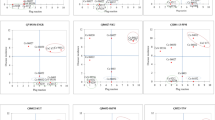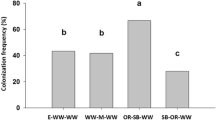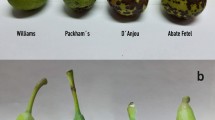Abstract
Zonate leaf spot (Gloeocercospora sorghi) is a common disease in Sorghum bicolor producing areas of the U.S., but little is known about its biology, virulence and severity on S. bicolor, Zea mays, and related crop grassweeds. Greenhouse studies were conducted to determine and compare the virulence and severity of G. sorghi on 10 commercially available sorghum hybrids, four Z. mays hybrids and selected grassweed species including Sorghum bicolor (grain sorghum and shattercane biotypes) and Sorghum halepense (Johnsongrass), two of the most problematic arable weeds. Plants from the respective species were inoculated with a local G. sorghi isolate and maintained in a dew-chamber at 24 °C for 24 h and then incubated under greenhouse conditions for 4 weeks. Plants were observed for lesion expression and rated using a modified Horsfall-Barrett scale (0–10). The first symptoms of infection were visible within 24 h following inoculation on shattercane and S. bicolor hybrids. Symptoms consisted of small, non-diagnostic purple lesions on the leaves. Results showed that S. bicolor, S. halepense and shattercane were susceptible to G. sorghi. All other species tested in this study were not infected. More particularly, disease severity, increased from a rating of 3 to 10 on sorghum and from 2 to 7 on S. halepense between 2 and 23 days after inoculation, respectively. However, disease severity on shattercane increased rapidly from 3.5 to 10 between 2 and 8 days after inoculation, respectively. Among the sorghum hybrids tested, FFR-322 appeared to be the most resistant to G. sorghi while Pioneer 83G66 appeared to be the most susceptible. Z. mays hybrids were not infected by the fungus used in this study. G. sorghi could be used effectively to manage shattercane and S. halepense infestations occurring in Z. mays and S. bicolor fields consisting of specific G. sorghi-resistant hybrids.




Similar content being viewed by others
References
Adams, D. & May, M. L. (1989). Growing grain sorghum in Arkansas. Cooperative extension service. University of Arkansas and the United States Department of Agriculture. MP 297. Little Rock: Pub. Cooperative Extension Service. pp. 44.
Carson, M. L. (1999). Diseases of minor importance or limited occurrence. In D.G.White (Ed.), Compendium of Corn Diseases (pp. 23–25). American Phytopathological society, St. Paul.
Dean, J. L. (1968). Germination and overwintering of sclerotia of Gloeocercospora sorghi. Phytopathology, 58, 113–114.
Duke, S. O. (1986). Microbially produced phytotoxins as herbicides- a perspective. In A. R. Putnam & D. S. Tang (Eds.), The Science of allelopathy (pp. 287–304). New York: Wiley-Interscience.
Duke, S. O. (1990). Overview of herbicide mechanisms of action. Environmental Health Perspective, 87, 262–271.
Evidente, A., Capasso, R., & Cutignano, A. (1998). Ascaullitoxin, a phytotoxic bis-aminoacid N-glucoside Ascochyta caulina. Phytochemistry, 48, 1131–1137.
Franklin, C. D. (1986). Zonate leaf spot. In R. A. Frederiksen (Ed.), Compendium of sorghum diseases (pp. 12–13). St. Paul: American Phytopathological Society.
Hans, S. R., & Johnson, W. G. (2002). Influence of shattercane [Sorghum bicolor (L.) Moench.] interference on corn (Zea mays L.) yield and nitrogen accumulation. Weed Technology, 16, 787–791.
Heap, I. (2016). The International Survey of Herbicide Resistant Weeds. Online. Internet; [cited on 2016 April 15]. Available from: www.weedscience.org.
Hoagland, R. E. (2001). Microbial Allelochemicals and pathogens as bioherbicidal agents. Weed Technology, 15, 835–857.
Kharayar, B. S., & Singh, Y. (2012). Biological control of zonate leaf spot of sorghum caysed by Gloeocercodpora sorghi. International Journal of Plant Protection, 5, 401–404.
Kucharek, T. (1992). Foliar and head diseases of sorghum in Florida. University of Florida, Gainesville. Circular no. 1073.
Lydon, J., & Duke, S. O. (1999). Inhibitors of glutamine biosysnthesis. In B. K. Singh (Ed.), Plant amino acids: Biochemistry and biotechnology (pp. 445–464). New York: Marcel Dekker.
Mitchell, J. K., Yerkes, C. N., Racine, S. R., & Lewis, E. H. (2008). The interaction of two potential fungal bioherbicides and a sub-letheal rate of fglyphosate for the control of shattercane. Biological Control, 46, 391–399.
Norsworthy, J. K., Ward, S. M., Shaw, D. R., Llewellyn, R. S., Nichols, R. L., Webster, T. M., Bradley, K. W., Frisvold, G., Powles, S. B., Burgos, N. R., Witt, W. W., & Barrett, M. (2012). Reducing the risks of herbicide resistance: Best management practices and recommendations. Weed Science, 60(sp1), 31–62.
Ogut, D., Nedim, Dogan M., Einhorn, G. (2012). Control of Chenopodium album L. utilizing two plant pathogenic fungi in combination with reduced doses of nicosulfuron. 25th German Conference on Weed Biology and Weed Control, March 13–15, 2012, Braunschweig, Germany Julius-Kühn-Archiv, 434. doi: 10.5073/jka.2012.434.035.
Pfirter, H. A., & Defago, G. (1998). The potential of Stagonospora sp. as a mycoherbicide for field bindweed. Biocontrol Science and Technology, 8, 93–101.
Varvel, G. E., & Wilhelm, W. W. (2003). Soybean nitrogen contribution to corn and sorghum in western corn belt rotations. Agronomy Journal, 95, 1220–1225.
Werle, R., Jhala, A. J., Yerka, M. K., Dille, J. A., & Lindquist, J. L. (2016). Distribution of herbicide-resistant shattercane and Johnsongrass populations in sorghum production areas of Nebraska and northern Kansas. Agronomy Journal, 108, 321–328.
Wesley, A., Elmore, C. D., & Spurlock, S. R. (2001). Deep tillage and crop rotation effects on cotton, soybean, and grain sorghum on clayey soils Richard. Agronomy Journal, 93, 170–178.
Acknowledgements
The authors are indebted to Dr. D.O. TeBeest and Dr. L.R. Oliver for the technical support and advice.
Author information
Authors and Affiliations
Corresponding author
Rights and permissions
About this article
Cite this article
Bararpout, M.T., Korres, N.E., Allen, T.W. et al. Infection of Sorghum bicolor, selected grass species and Zea mays by Gloeocercospora sorghi, causal pathogen of zonate leaf spot. Phytoparasitica 45, 211–217 (2017). https://doi.org/10.1007/s12600-017-0583-0
Received:
Accepted:
Published:
Issue Date:
DOI: https://doi.org/10.1007/s12600-017-0583-0




